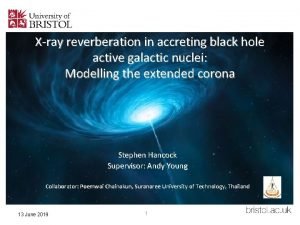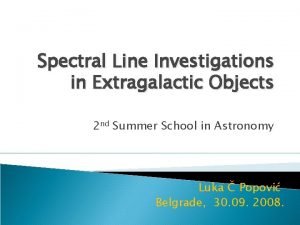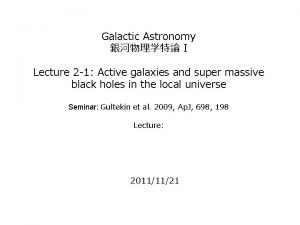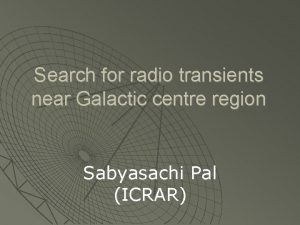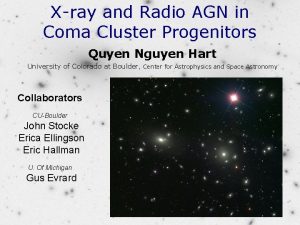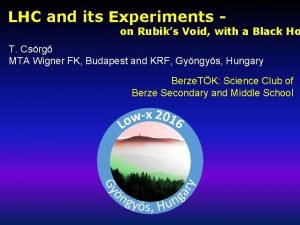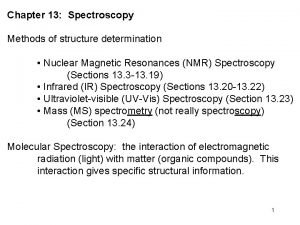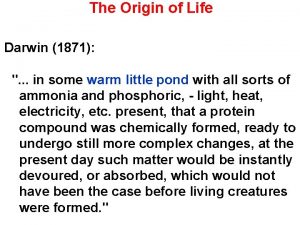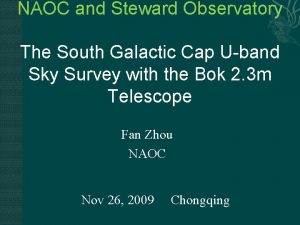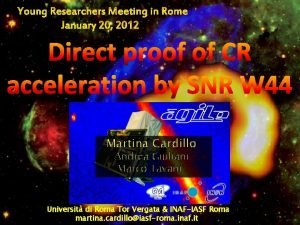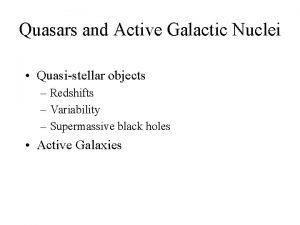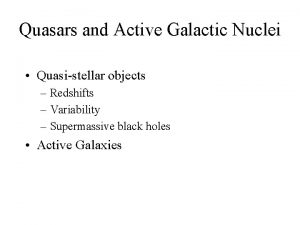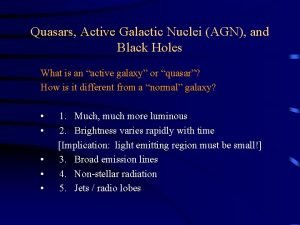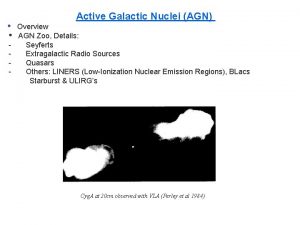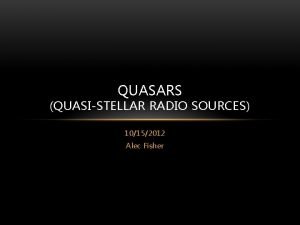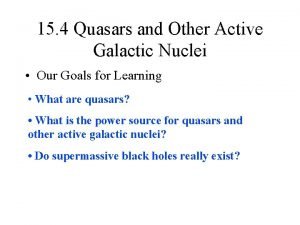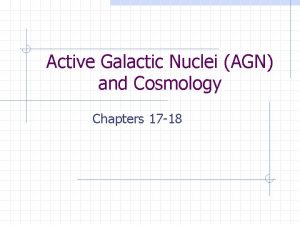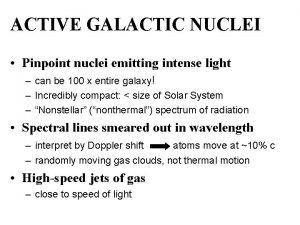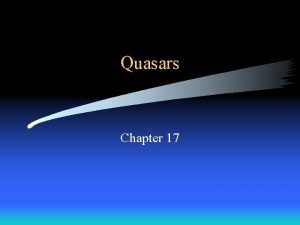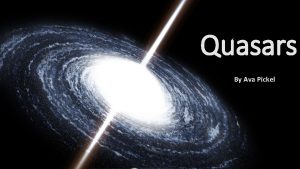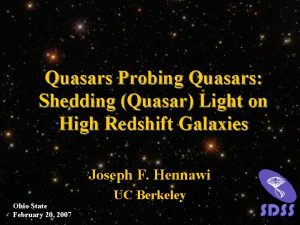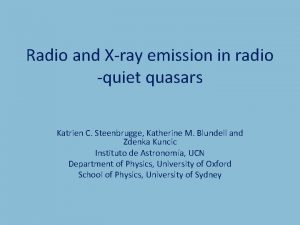NOTES Active Galactic Nuclei AGN QUASARS Radio QuasiStellar


















- Slides: 18


NOTES: Active Galactic Nuclei (AGN) QUASARS: Radio Quasi-Stellar Objects. Maarten Schmidt examined 3 C 273 (3 C=Third Cambridge Catalog of Radio sources) and found its distance from its redshift to be 2 billion light years--not a star, and L = 1040 watts--1, 000 L (MW)!!. 8 to 14(? ) Billion years--distance range. L = 1038 -1042 watts. Energy comes from a region solar system-sized. Radio Jets. A thermal (synchotron) and non-thermal (black-body) continuous spectrum & broad (gas with varying speeds) lines. Found to have stars around them (galaxies) in most cases. Supermassive BH model suggests a billion solar masses by Eddington Limit--Max M(BH) = L /30, 000 (Solar Ms & Ls). If larger mass, luminosity would blow away infalling material. QSO's: Radio quiet Quasi-Stellar Objects. ACTIVE GALAXIES: On average, seen at closer distances than QSOs. Some in nearby clusters. Seyfert Galaxies: ~1037 watts, 1, 000 x dimmer than QSOs. Type I--broad (narrow peak) and narrow emission lines. Type II--just narrow emission lines. ). Radio Galaxies: Less luminous than Quasars. Often elliptical or peculiar (collision-stimulated? ).

3 C 273—first thought To be a strange star. Host galaxy— blocking light from core First discovered Quasar

QUASARS: Quasi-Stellar Radio Objects. Maarten Schmidt examined 3 C 273 (3 C=Third Cambridge Catalog of Radio sources) and found its distance from its redshift to be 2 billion light years--not a star, and L = 1040 watts--1, 000 L (MW)!!

Quasars are the dinosaurs of the cosmos. They went extinct 0. 8 billion years ago, because we don’t see any closer than 0. 8 billion light years.

Quasars: Distance: 8 to 14 Billion years. L = 1038 -1042 watts. Energy comes from a region solar system-sized. Radio Jets. Found to have stars around them (galaxies) in most cases.

Quasars have a thermal (black body) and non-thermal (synchotron) continuous spectrum & broad lines.

Broad vs Narrow lines: material moving in many directions Or orbiting can produce a spread of Doppler Shifts.

Supermassive BH model of quasars suggests a billion solar masses by Eddington Limit--Max M(BH) = L /30, 000 (Solar Ms & Ls). If larger, luminosity would blow away infalling material.

QSO's: Radio quiet Quasi-Stellar Objects. Double QSO 0512 -3329, 0. 64 arcsec separation

Radio Loud vs radio quiet?

In terms of luminosity, Quasars (& QSOs) are the poppa bears, Active Galaxies the momma bears, and Present Day Galaxies like the Milky way are the baby bears. Successively about 1000 x less luminous.

ACTIVE GALAXIES: On average, seen at closer distances than QSOs. Some in nearby clusters. Seyfert Galaxies: ~1037 watts, 1, 000 x dimmer than QSOs. Type I--broad (narrow peak) and narrow emission lines. Type II--just narrow emission lines. ). Radio Galaxies: Less luminous than Quasars. Often elliptical or peculiar (collision-stimulated? ).


Radio Galaxy Centaurus A. Collision of spiral with elliptical?

Blazars: variable quasarlike radio sources, with periods of years --like galactic pulsars. (Exs. BL Lacertae--3 C 279 Burst in 1937 and 1943— 6 year period. )

Unified Model of active galaxies: AGN (Active Galactic Nuclei). In some cases, they may be the same thing seen from different angles.

Naked Quasars: no stars around them --NOT AGN. White Hole? 7 discovered in 1995.
 Reverberation
Reverberation Active galactic nuclei
Active galactic nuclei Active galactic nuclei
Active galactic nuclei Galactic center radio transients
Galactic center radio transients Agn
Agn Ncp for agn
Ncp for agn Difference between nephrotic and nephritic syndrome
Difference between nephrotic and nephritic syndrome Agn rubik's cube
Agn rubik's cube Nmr active and inactive nuclei
Nmr active and inactive nuclei Awin support
Awin support Galactic address
Galactic address City model
City model Star wars combine
Star wars combine Urban structure models
Urban structure models Urban realms model
Urban realms model Galactic habitable zone
Galactic habitable zone Galactic phonics ure
Galactic phonics ure Galactic cap review
Galactic cap review Alessandro cardillo
Alessandro cardillo
